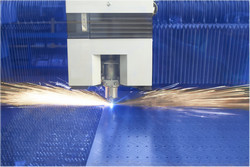Diamond-cutting laser technology gives EU industry the edge
Diamond and other ultra-hard materials are used in numerous industrial and manufacturing sectors. Small particles of diamond, for example, can be embedded in saw blades, drill bits and grinding wheels for the purpose of cutting, drilling or grinding. They can also be ground into a powder and made into a diamond paste that is used for polishing or for very fine grinding. Paradoxically however, it is this extreme hardness – the very quality that makes industrial diamonds so valuable – that has presented a consistent challenge in developing the next generation of high performance tools. Achieving precise complex 3D freeform geometries and structures from industrial diamonds and other ultra-hard materials has proved to be technically very difficult. The EU-funded DIPLAT project, launched in January 2013, aims to address this issue by pioneering a technological breakthrough based on lasers. This will enable European industry to fully capitalise on the growing market for high-performance machining and tooling. Indeed, it is hoped that the project, which will receive a total of EUR 3.2 million in EU funding, will have open up new possibilities with respect to high performance tool design. This will provide highly specialised European SMEs in the tooling and tooling machinery sector with a distinct competitive advantage. DIPLAT aims to harness the potential of high brilliance short and ultra-short pulsed lasers. This tooling technology will be based on 3D Pulsed Laser Ablation (PLA), and will be developed and demonstrated for various industrial applications. Laser ablation is the process of removing material from a solid surface by irradiating it with a laser beam, achieving a smoother and more defined edge. One specific material the project is working with is polycrystalline diamond (PCD). This material typically provides abrasion resistance of up to 500 times that of cemented carbide, and its high thermal conductivity allows heat to be transferred away from the cutting edge, preventing rapid tool wear. PCD products are used extensively by the automotive, aerospace, electronics, woodworking and optical industries. While PCD materials with larger crystals exhibit greater abrasion resistance, they result in a rougher cutting edge. Conversely, smaller crystals result in a sharper cutting edge but shorter tool life. Cubic boron nitride (CBN) is another ultra-hard material used as an abrasive (it is the second hardest material after synthetic diamond). One of the physical advantages of CBN compared to conventional abrasives is that, in addition to being harder at ambient temperature, it maintains this hardness over a wide temperature range. The DIPLAT project aims to enable tool manufacturers to design very specific functional surfaces (with controlled micro geometries) from these materials, in order to provide industry with the exact high performance tool required. The project, due for completion in July 2016, will then demonstrate the superior performance and functionality of these new tools in challenging industrial applications. DIPLAT marks a cornerstone with regards to novel tooling technology, and will help push European manufacturing towards the cutting edge of high performance machining. This will offer end users enhanced functionality, outstanding machine performance and ultimately boost European competitiveness. For further information please visit: DIPLAT www.fp7-diplat.eu/
Countries
Switzerland



